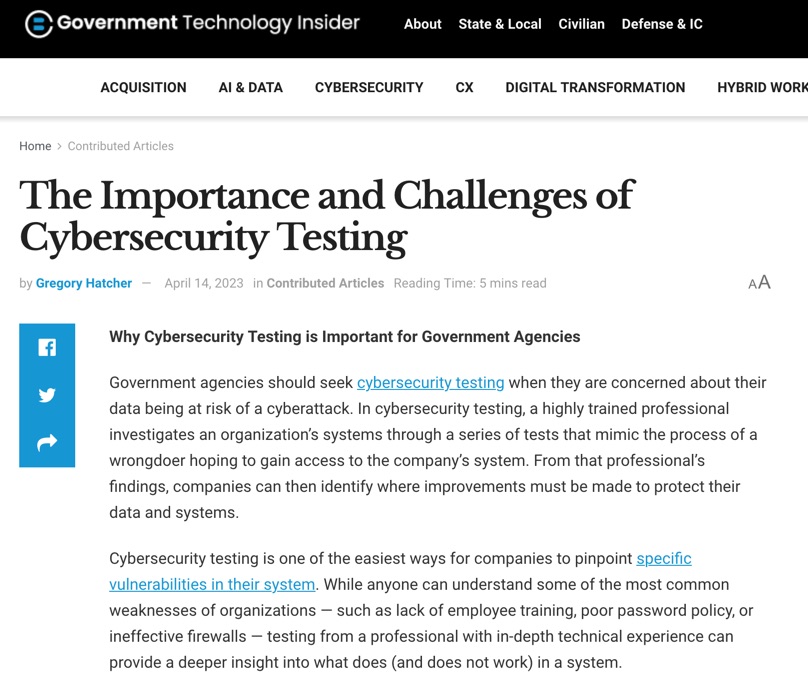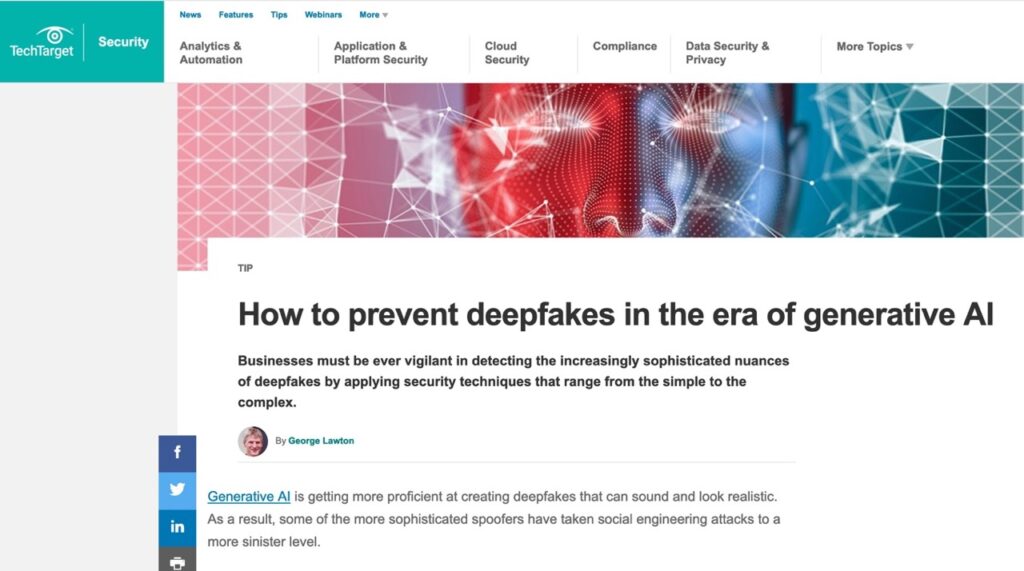Making Sure Lost Data Stays Lost

Steven Lawton published an article on Dark Reading that explores the potential risks of retired hardware and forgotten cloud virtual machines. A recent report revealed that 56% of decommissioned routers sold on the secondary market contained sensitive corporate material, highlighting the regular exposure of confidential data. Greg Hatcher, CEO of cybersecurity consultancy White Knight Labs, explains that cloud-based vulnerabilities usually result from misconfigurations or naïve actions. He emphasizes the importance of having both hardware and software asset inventories to protect networks and cloud environments. Hatcher also notes that sensitive data might not stay hidden, even when applications are deleted from retired hard disks. Access policies can remediate vulnerabilities by allowing specific individuals to access data within a platform, while guidelines and security frameworks can help define controls for decommissioning hardware and protecting data.
“Can’t Stop the Phish” – Tips for Warming Up Your Email Domain Right
Introduction Phishing continues to be a lucrative vector for adversaries year after year. In 2022, for intrusions observed by Mandiant, phishing was the second most utilized vector for initial access. When Red Teaming against mature organizations with up-to-date and well configured external attack surfaces, phishing is often the method of initial access. To give the readers a recent example, I was on an engagement where one of the goals was to bypass MFA and compromise a user’s Office365 account. The target had implemented geo-location based restrictions, MFA for users, and conducted user awareness trainings. To get past these controls, a customized version of Evilginx was hosted in the same country as the target. This server was protected behind an Apache reverse proxy and Azure CDN to get through the corporate web proxy. The phishing email contained a PDF, formatted to the target’s branding (from OSINT) with a ruse that required users to re-authenticate to their Office365 accounts as part of a cloud migration. The phish was sent using Office365 with an Azure tenant, which helped get through the email security solution (more on this later). The campaign began, and eventually a user’s session was successfully stolen, resulting in access to business critical data. Interestingly, although a few users reported the phish, the investigating security analyst did not identify anything malicious about the email and marked the reported phish as a false positive. The engagement concluded with valuable lessons learnt from identifying gaps in response processes, user awareness, and an ‘aha moment’ for the executives. Reel It In: Landing The Phish Landing an email in a recipient’s inbox can be a challenge, for both cold emailing and spear phishing. To avoid getting caught in spam filters, it’s important to follow a few best practices. Never use typosquatted target domains. For instance, Mimecast has an ‘Impersonation rule’ to prevent typosquatted domains from landing in an inbox. Instead, purchase an expired domain that resembles a vendor that may be related to the target. For instance, ‘fortinetglobal.com’ or ‘contoso.crowdstrikeglobal.com’. I tend to rely on Microsoft’s domains. Azure tenants provide a subdomain of ‘onmicrosoft.com’. Alternatively, you could rely on Outlook (‘@outlook.com’), and impersonate a specific user from the target, such as IT support. Rely on your OSINT skills to identify the email naming syntax, signature, and profile picture of the user you want to impersonate. Most RT shops use reputed providers such as Office365, Mailgun, Outlook, Amazon SES, or Google Workspace. Some folks still use their own Postfix SMTP server. To avoid blacklisted source IPs, you may want to use a VPN on the host you use to send emails. Enumerate the target’s DNS TXT records to identify allowed third-party marketing providers. A quick Shodan lookup of the allowed IPs should identify the associated vendor. Rely on the same service to send your phish, for example, Sendgrid or Klaviyo. Sender policy framework (SPF): Identifies the mail servers and domains that are allowed to send email on behalf of your domain. DomainKeys identified mail (DKIM): Digitally sign emails using a cryptographic signature—so recipients can verify that an email was sent by your domain and not spoofed by a third party. Domain-based message authentication (DMARC): Allows email senders to specify what should happen if an email fails the SPF record check —for example, whether it should be rejected or delivered to the recipient’s inbox. Words such as Free, Prize, Urgent, Giveaway, Click Here, Discount etc. are associated with spam or unsolicited email and cause your email to be automatically sent to Junk or not delivered at all. I prefer to send my phishes in three stages. For instance, on a Friday I’d send a ‘Downtime Notification’ informing users that they may need to re-authenticate to their accounts after a scheduled maintenance activity. This email would not contain anything suspicious—no links, no action required—it’s only informational. The following Monday, I’d reply to the same email thread, with the phish requesting users authenticate on the provided link. On Tuesday, I’d send a ‘Gentle Reminder’ email, once again replying to the same mail thread. The user compromised from the example in the introduction section was phished with the ‘Gentle Reminder’. For a targeted attack, it’s recommended to establish two-way communication with the user before sending the main phish. With Google Workspace: Create a document themed according to target’s branding → Embed payload URL within sheet → Add victim as ‘Commentator’ → Victim receives an email from ‘comments-noreply@docs.google.com’ With SharePoint: Create a folder or document themed according to target’s branding → Embed payload URL within sheet → Provide only read access to anyone with the URL → Share the folder\file with victim’s email ID → Embedded link is a subdomain of ‘sharepoint.com’. Personally, I’ve had better success landing shared files instead of shared folders on SharePoint. SharePoint also provides notifications when users access the document. Instead, provide a link in the email, redirecting the user to the site that’s hosting the payload. Using your own website provides benefits such as user\bot tracking and quick payload swaps. Use JavaScript to hide the payload from the <a href=””> tag, and download based on an event such as onclick(). Alternatively, Azure blob storage, Azure app services, AWS S3 buckets or IPFS are worth considering. Use ‘https://www.mail-tester.com’ and Azure’s message header analyzer. Note that just because you get a 10/10 score, does not mean you will land the phish in your target’s inbox. This brings us to the idea of email sender reputation. Warm It Up Email sender reputation refers to the perceived trustworthiness of the sender of an email, as determined by various email service providers and spam filters. This reputation is based on a number of factors such as the sender’s email address, the content of the email, and the frequency and consistency of sending emails. When new senders appear, they’re treated more suspiciously than senders with a previously-established history of sending email messages (think of it as a probation period). For instance, if you try to send more than 20 emails
Masking the Implant with Stack Encryption
This article is a demonstration of memory-based detection and evasion techniques. Whenever you build a Command & Control or you perform threat hunting, there will be scenarios when you might need to analyze the memory artifacts of a specific system—something that is really useful during your live forensics or when you’re going to perform an incident response on a host by segregating that host from the network. In such scenarios, it would be required to identify the payload that is currently running in memory. We will be taking a look at some of the examples of how that payload investigation can be performed, and how that investigation can be bypassed as well. A lot of times during an engagement, an engineer might execute a payload: either Cobalt Strike, Havoc or any other open source C2s that are currently there. There are specific scenarios where the red teamer might want to execute a command on the endpoint, which gathers a lot of strings and sends that to your C2 host. These strings can be username, hostname, or even information related to your command and control server itself and the information might also be encrypted during transit. However, when the payload sleeps on the endpoint, and the red teamer adds sleep and jitter to the beacon, these commands need to be stored in an encrypted way. In this current scenario, this information can be either stored into a heap or on stack. Regarding heap memory, usually we don’t have to worry about it because you can eventually walk a heap, extract information, and encrypt when you are sleeping. However, things change a bit when we talk about stack encryption. The problem with loaders In a traditional shellcode loader, the shellcode is stored in stack memory since it is stored in a variable inside or outside of a function. When the shellcode is written with WriteProcessMemory to a local/remote process, not only is the shellcode stored in that particular memory but also it remains stored in the stack, where the variable lives. Finding the stack To quickly identify where the stack is located, we need to retrieve the RSP address. This register will contain the address of the top of the stack. While the top of the stack is easily identifiable, the bottom is much harder as the stack dynamically increases and/or decreases in size based on the variables that are stored and freed as the code is executed. Luckily VirtualQuery makes it so easy for us to retrieve information about the range of pages in the virtual address space of the calling process. So using the RSP address that we found previously allows us to determine the top and the bottom of the stack: Suspending the thread to avoid abnormal behavior It is required to suspend the process before encrypting or decrypting the stack. This is because modifying the stack while the process is still running can cause unpredictable behavior and potential crashes. To suspend the process, we can use the SuspendThread function from the Windows API, which suspends the execution of a thread until it is resumed with the ResumeThread function. Encrypting what we need to hide Encrypting from the beginning of the page to the bottom of the stack might look suspicious and is not the most OPSEC-safe approach. Instead, we will encrypt where the stack actually begins (RSP address) and the bottom of the stack (minus 8 bytes). Below is the image of the range that should be encrypted, starting from RSP address (where the plaintext strings and the shellcode is stored) until the end of the stack: The encryption routine is pretty simple; XOR byte per byte until you reach the end of the stack: If we analyze the stack of the loader, we can clearly see what the stack will look like after the encryption: There’s no sleepmask without sleeping Some modern detection solutions possess countermeasures against a basic Sleep(). For example, hooking sleep functions like Sleep in C/C++ or Thread.Sleep in C# to nullify the sleep, but also fast forwarding. There is already a nice technique that leverages CPU cycles to perform a custom sleep. I am not going to further describe how it works as it is already well-explained here in this article. Wrapping everything up In conclusion, understanding memory-based detection and evasion techniques is crucial for effective threat hunting and incident response. Investigating the payloads that are running in memory can provide critical information about a system’s state, but it can also be bypassed through stack encryption techniques. The code for this PoC can be found in this GitHub repo. Credits https://shubakki.github.io/posts/2022/12/detecting-and-evading-sandboxing-through-time-based-evasion/ White Knight Labs – Red Team Engagements White Knight Labs is an expert in conducting red team engagements that are tailored to the specific needs of our clients. We believe that every organization has unique security requirements, which is why we work closely with our clients to develop customized testing plans that align with their objectives and security goals. As a tactical, objective-based company, we excel in intense scenarios and strive to provide our clients with a realistic assessment of their security posture. Our experienced team employs advanced tactics and techniques to simulate real-world attacks and identify vulnerabilities that could be exploited by malicious actors. Our red team engagements include a thorough analysis of your organization’s defenses and culminate in a detailed report that outlines our findings and recommendations for strengthening your security posture. With White Knight Labs’ red team engagements, you can be confident that your organization is better equipped to defend against targeted attacks and other sophisticated threats.
Hello Chaos Podcast chats with Greg Hatcher

Jennifer Oladipo and Jennifer Sutton host Hello Chaos, a podcast that meets entrepreneurs at every point in their journey. It’s real talk about struggles and triumphs. White Knight Founder Gregory Hatcher had the opportunity to join them and discuss his founder journey and experience in network and web app penetration testing, red teaming, Python, and reverse engineering.
The Importance and Challenges of Cybersecurity Testing

In an article written by White Knight Labs cofounder Greg Hatcher and published in Government Technology Insider, Greg emphasizes the significance of cybersecurity testing for government agencies and companies to identify their vulnerabilities and improve their cybersecurity measures. The article mentions that cybersecurity partners vary in cost and expertise, and the greater risk an agency faces, the more intricate its testing will need to be, and the more experience its cybersecurity team will need. The article also highlights two types of cybersecurity testing: penetration testing and advanced adversarial emulation. The article also includes discussion of cybersecurity testing, vulnerabilities, and advanced adversarial emulation.
Unveiling OSINT Techniques: Exploring LinkedIn, Illicit Services, and Dehashed for Information Gathering
Introduction Open Source Intelligence (OSINT) is becoming increasingly popular due to its effectiveness in gathering information. The purpose of this blog is to explore the use of LinkedIn, Illicit Services, and Dehashed for OSINT purposes. This blog will also discuss ethical and legal considerations for using these techniques I. Identifying a Company for the Proof of Concept (POC) For the purpose of this blog, Ronin Innovations Group was chosen as the company to demonstrate the effectiveness of OSINT techniques. Ronin Innovations Group is a rapidly growing technology company that specializes in developing innovative solutions for various industries, including healthcare, finance, and telecommunications. The company has a global presence, with operations in multiple countries, and is known for its commitment to research and development to stay ahead of the competition. With its focus on cutting-edge technology and solutions, Ronin Innovations Group is an ideal target for OSINT investigations to gather information on key personnel, company strategies, and potential vulnerabilities. II. Gathering Information from LinkedIn A. Utilizing Search Filters and Advanced Techniques LinkedIn is an essential tool for gathering information about the employees of a company. Using LinkedIn search filters can help identify specific industries and job titles. Advanced search techniques can also be used to find relevant information. Results of LinkedIn Scraping To scrape employee data from LinkedIn, the LinkedInDumper tool was used. The program was able to identify over 1,000 active Ronin Innovations Group employees on LinkedIn. However, due to the limitations of the LinkedInDumper tool, it was only able to export 65 employee accounts. This was because LinkedIn restricts the number of search results to the first 1,000, and not all employee profiles may be public, making it difficult to extract the first name, last name, and profile URL of some employee accounts. The LinkedInDumper tool only displays public profiles, and those that are private or have default values such as “LinkedIn” as the first name and “Member” as the last name are not included. Additionally, some LinkedIn users may name their profile using various salutations, abbreviations, emojis, and middle names, which may be challenging to filter out. It is essential to note that the LinkedInDumper tool relies on an unofficial API called Voyager and is not using the official LinkedIn API, which may also contribute to limitations in data extraction. III. Exploring Illicit Services Illicit Services are services available on the dark web that can be used for gathering personal and sensitive information. These services are accessible for free and can include services such as password cracking and phone number reverse lookup. These services can be used to find leaked credentials and other sensitive information obtained through data breaches. A. Risks and Legal Implications Utilizing the service Illicit Services for OSINT purposes can expose an individual to legal and personal risks. The use of these services can violate various laws and regulations, including data privacy laws and intellectual property laws. It is crucial to consider the legal implications of accessing such services before using them for OSINT investigations. Furthermore, using these services can also result in personal risks, including the exposure of sensitive information or becoming a victim of cybercrime. It is important to exercise caution and use these services only for lawful and ethical purposes. B. Results of OSINT with Illicit Services By utilizing the Illicit-Services-Enum-Script, a custom script created by White Knight Labs, we were able to conduct the enumeration of accounts based on our search criteria, resulting in the initial identification of 40 accounts. However, through a meticulous manual examination of the gathered data, we were able to validate an additional 14 employee accounts that were still active at Ronin Innovations Group. These newly discovered accounts have been seamlessly integrated into the LinkedInDumper results, resulting in a total of 79 identified accounts that perfectly met the objectives of our OSINT research. During the OSINT investigation of Ronin Innovations Group, extensive personal information was uncovered on employee Haley. Her LinkedIn profile provided details on her employment, gender, location, inferred salary, and various social media usernames and contact information. Further research revealed additional information, including her attendance at the University of Toledo and her Twitter username. In addition, an online search uncovered Haley’s address and vehicle information, including the make, model, and VIN number. The investigation also yielded some information on employees Drew and Diana, including their contact information and employment details at Ronin Innovations Group. While utilizing Illicit Services for OSINT investigations can provide valuable data, it is crucial to consider the risks and legal implications associated with accessing such services. It is important to exercise caution and use these services only for lawful and ethical purposes. IV. Leveraging Dehashed for OSINT Investigations A. Introduction to Dehashed Dehashed is a paid data breach search engine that can be used to find leaked credentials and other sensitive information. For this investigation, a combination of two tools were used, specifically, the Dehashed Query and Crack and the dehashQuery tool. B. Benefits and Limitations Using Dehashed for OSINT investigations can provide valuable data, including leaked credentials and sensitive information. However, it is crucial to consider the accuracy and completeness of the information obtained. It is also important to note that Dehashed is a paid service and requires a subscription to access all features. C. Results of Dehashed Investigation The results obtained from Dehashed for the Ronin Innovations Group investigation included 14 cracked hashes and 20 uncracked hashes, but these were not relevant to the investigation as they were associated with ex-employees. However, Dehashed provided additional value by allowing us to reverse a phone number that was collected from Illicit Services for Diana. This helped us confirm the phone number’s match and current address. V. Combining Techniques and Analyzing the Gathered Information A. Applying Techniques to the Chosen Target To effectively gather information about potential targets for a phishing campaign, it is crucial to apply the techniques discussed in the blog. In this case, the chosen target is Ronin Innovations Group. The following information was obtained using OSINT techniques:
Cobalt Strike may be a double-edged sword but pentesting tools are invaluable, says expert

In the article by Damien Black and posted on CyberNews, Greg Hatcher, co-founder of White Knight Labs, discusses the growing concern surrounding the use of Cobalt Strike, a widely recognized penetration testing tool, by cybercriminals for malicious activities. The article highlights the challenges in stopping malware created with Cobalt Strike and explores the potential implications of advancements in artificial intelligence and machine learning on malware development. Hatcher also mentions other dual-use tools like BloodHound and Burp Suite, which can be utilized by both attackers and defenders in the cybersecurity realm. He emphasizes the significance of strong cybersecurity practices, such as implementing multifactor authentication and keeping operating systems updated, to prevent cyberattacks. Furthermore, the article cautions that cybercriminals are increasingly incorporating code from pentesting tools into their custom malware, underlining the need for constant vigilance within the cybersecurity industry. Read full article
How to prevent deepfakes in the era of generative AI

An article by George Lawton published on TechTarget discusses the growing threat of deepfake attacks in the era of generative AI and provides recommendations for preventing and detecting them, featuring insights from Greg Hatcher, co-founder of White Knight Labs. The article highlights the importance of developing strong security procedures, including multistep authentication processes, and staying up to date on the latest tools and technologies to thwart increasingly sophisticated deepfakes. Greg Hatcher emphasizes the telltale signs of audio deepfakes, such as choppy sentences, unusual word choices, and abnormal inflection or tone of voice, and the use of forensic analysis and specialized software for reverse image searches to detect manipulation or alteration. The article cites examples of deepfake attacks, including a $243,000 bank transfer resulting from a phone request impersonation and a $35 million fraudulent bank transfer timed perfectly with a company acquisition. The article also warns of the likely proliferation of deepfakes as a service and the need for collaboration between the public and private sectors to promote truth in social engagement. By staying vigilant and informed, businesses and individuals can better protect themselves against the deceptive power of deepfakes in this rapidly advancing era of generative AI. Read article
Why CFOs Need to Evaluate and Prioritize Cybersecurity Initiatives

In a post on Rush Hour Times, the author emphasizes the crucial role cybersecurity plays for CFOs and C-suite members. Greg Hatcher, CEO of White Knight Labs, highlights the risks of cyber threats and their potential impact on financial performance, reputation, and customer trust. The article provides recommendations for CFOs to prioritize cybersecurity investments and ensure compliance with data protection regulations. These recommendations include conducting regular security training, implementing access controls, monitoring employee activities, and performing comprehensive risk assessments to identify potential threats and vulnerabilities. Hatcher also stresses the importance of cloud provider security protocols and compliance requirements, as well as the need for employee training on securely accessing and managing cloud data. Finally, the article discusses the cybersecurity risks associated with remote and hybrid working policies, and provides recommendations for minimizing these risks, such as implementing multi-factor authentication and endpoint protection, and setting up VPNs to automatically disconnect when not in use.
You’re likely to see more robot security guards

An article written by James McGinnis of the Bucks County Courier Times discusses the increasing use of robot security guards in various public spaces, including stores, casinos, college campuses, and hospitals. The robots, designed to record 360-degree HD video, detect thermal anomalies, and scan license plates, are already being used by companies such as Lowe’s and Knightscope. While some experts predict that robots will eventually replace some human labor, others argue that robots will provide companies with much more than security, such as collecting consumer data on “pattern of life” for companies seeking to sell products. However, the article also raises concerns about the use of robots and the data collected by them, as well as the need for humans to become more comfortable with the machines. White Knight Labs CEO Greg Hatcher is quoted in the article. read Article